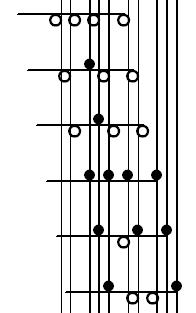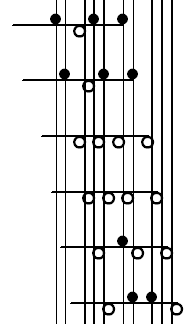6-6 version of Klavarskribo
There has been some recent discussion in the MNMA forum about an alternative version of Klavarskribo that its inventor (Cornelis Pot) had designed for chromatic, 6-6 keyboards (i.e. keyboards having 6 white keys and 6 black keys in each octave, as opposed to 7 white keys and 5 black keys). Below is my attempt at reconstructing an image from a verbal description (posted in the forum) of an image that was published in a Dutch article in the February 1972 issue of Klavar-Nieuws:

The above example contains all 12 major triads (with doubled roots), traversing over them in two sequences that correspond to the two whole-tone scales. As you can see, there are just two keyboard patterns to learn. (With a Janko keyboard that has more than just two rows of keys, then there’s really just one keyboard pattern to learn. To move up a half step, you’d just shift from the first and second rows to the second and third rows, keeping your hand in the same position.) A comparison with the Klavarskribo equivalent for the traditional piano keyboard shows just how irregular the traditional keyboard is, and how many patterns you have to learn within those same 12 keys (for chords, scales, etc.).
Below are the first six chords (in regular Klavarskribo notation), corresponding to the whole-tone scale starting on C. One thing that was apparently not made explicit in the Klavar-Nieuws article was which key is indicated by the thicker vertical lines in the 6-6 notation above. In my transcription to regular Klavarskribo, I just chose a mapping: B for the thicker lines so that C lands just to the right of each thicker vertical line in the 6-6 notation. Thus, the first sequence would then start with the C-Major chord:

And here’s the second sequence, traversing the whole-tone scale starting on D-flat:

As you can see, there’s nothing in these sequences that approaches the regularity of the 6-6 keyboard patterns. There’s a lot to discuss in comparing the two keyboard layouts—enough to leave for another blog post.
The message in the MNMA forum that described the 6-6 Klavar notation contained lots of fascinating insights, along with quotes relating to the 6-6 keyboard from a letter written by Pot. I wish I could link to it directly. The problem is that the MNMA forum messages are currently only accessible to members (although anyone can join). That may (hopefully) change in the near future and in fact is being discussed on the list right now.
Johannes K. Drinda said,
May 8, 2008 @ 9:10 am
The only other way to adapt Klavarskribo to the Janko keyboard layout would be correcting Klavarskribo’s notation, by tediously painting all C# and D# notes white and all E-notes black in each melody…
for with Janko it’s important to know which notes are which keys, namely; that all white notes are upper or lower row Janko keys and all black notes are middle row Janko keys (of a three row Janko layout).
In the meantime I realized why three Janko rows are required to allow for the same major & minor scale pattern in all scales. For instance:
To play the key C requires starting in the middle row and then select keys C#, D#, F, G , A or B of the upper Janko row, whereas…
to play the key C# requires starting in the lower row and then select keys C, D, E, F#, G# or A# in the middle Janko row and thus, maintaining the same fingering pattern.
With only two Janko rows one would need to learn two different fingering patterns for the lot.
I’m planing to create a plug-in Janko keyboard for my Synth. This way I can make decrease the key size (to PC size) and shorten its contact time. Now my “glued on Janko adapter” has the zebra piano Kbd. length of 84cm, yet the compact length shrinks it to a mere 67cm (13.4cm per octave). I already bought cheap, single PC switches from here: http://www.alltronics.com/cgi-bin/item/96B006/search/Keyboard%2DSwitch
This compact Kb. brings it closer to the advantages of button keyboards; i.e. it allows playing faster, because the keyboard layout is compacter and their contact/ action time is shorter.
Important is that the fingers are naturally & comfortably positioned. Thus, the PC keyboard’s spacing is perfect.
AXepjzcc said,
May 20, 2019 @ 11:48 pm
!!!Azzzjzj